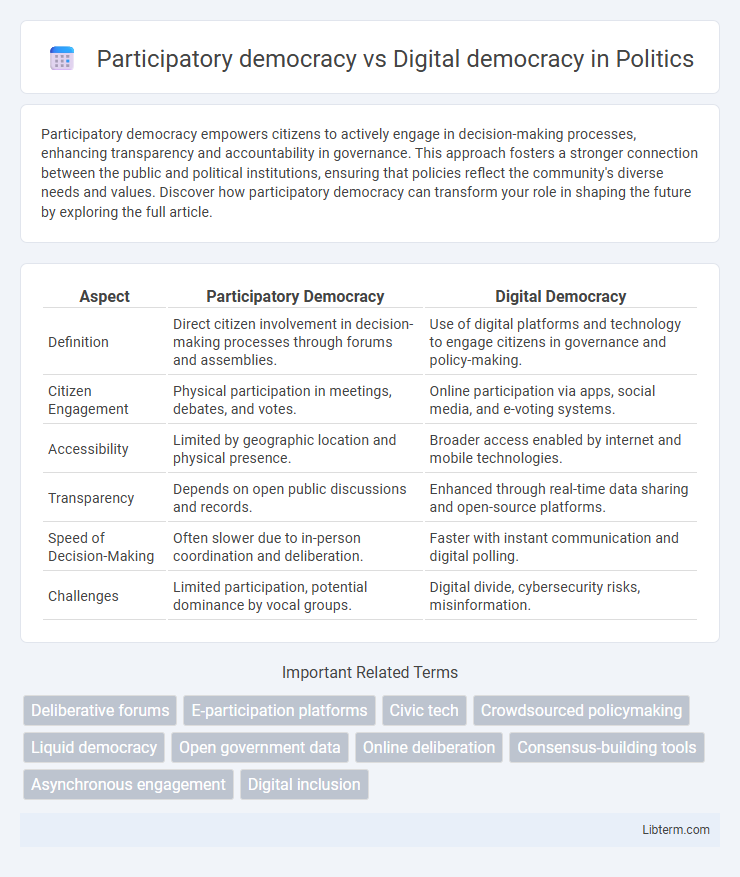Participatory democracy empowers citizens to actively engage in decision-making processes, enhancing transparency and accountability in governance. This approach fosters a stronger connection between the public and political institutions, ensuring that policies reflect the community's diverse needs and values. Discover how participatory democracy can transform your role in shaping the future by exploring the full article.
Table of Comparison
| Aspect | Participatory Democracy | Digital Democracy |
|---|---|---|
| Definition | Direct citizen involvement in decision-making processes through forums and assemblies. | Use of digital platforms and technology to engage citizens in governance and policy-making. |
| Citizen Engagement | Physical participation in meetings, debates, and votes. | Online participation via apps, social media, and e-voting systems. |
| Accessibility | Limited by geographic location and physical presence. | Broader access enabled by internet and mobile technologies. |
| Transparency | Depends on open public discussions and records. | Enhanced through real-time data sharing and open-source platforms. |
| Speed of Decision-Making | Often slower due to in-person coordination and deliberation. | Faster with instant communication and digital polling. |
| Challenges | Limited participation, potential dominance by vocal groups. | Digital divide, cybersecurity risks, misinformation. |
Understanding Participatory Democracy
Participatory democracy emphasizes direct citizen involvement in decision-making processes through forums, town halls, and community assemblies, ensuring that diverse voices shape public policy. It fosters active engagement by encouraging citizens to collaborate on legislation, budget allocations, and local governance, strengthening democratic legitimacy and accountability. This model contrasts with digital democracy, which primarily uses online platforms to facilitate participation but may lack the depth of face-to-face deliberation critical to participatory democracy.
Defining Digital Democracy
Digital democracy leverages digital technology to enhance citizen participation, enabling online voting, e-petitions, and virtual town halls that broaden accessibility and engagement. Unlike traditional participatory democracy, which relies on physical presence and face-to-face interaction, digital democracy removes geographical barriers and facilitates real-time decision-making through platforms and social media. This integration of information and communication technologies transforms democratic processes by increasing transparency, inclusivity, and responsiveness in governance.
Core Principles: Participation vs. Digital Engagement
Participatory democracy emphasizes direct involvement of citizens in decision-making processes, fostering face-to-face interactions and community deliberations to ensure inclusivity and transparency. Digital democracy leverages technology platforms to facilitate online engagement, enabling broader access and real-time participation, but often faces challenges related to digital divides and data security. Core principles distinguish participatory democracy's emphasis on physical presence and communal dialogue from digital democracy's focus on virtual connectivity and scalable citizen input.
Historical Evolution of Democratic Models
Participatory democracy, originating in ancient Athens, emphasizes direct citizen involvement in decision-making through assemblies and referenda, fostering grassroots engagement. Digital democracy, emerging in the 21st century, integrates information technology to enhance political participation, enabling online voting, digital forums, and real-time policy feedback. The historical evolution from traditional participatory models to digital platforms reflects a shift towards increased accessibility and efficiency in democratic processes.
Technological Innovations Shaping Democracy
Technological innovations in digital democracy utilize blockchain, artificial intelligence, and big data analytics to increase transparency and facilitate real-time citizen engagement, surpassing traditional participatory democracy methods reliant on physical meetings and paper ballots. Digital platforms enable wider access and inclusive participation through online voting, digital deliberation forums, and social media integration, reducing logistical barriers and expanding civic involvement. These advancements transform democratic processes by enabling scalable, efficient, and secure citizen input, fundamentally reshaping governance structures in the digital age.
Inclusivity and Accessibility in Both Models
Participatory democracy emphasizes direct citizen involvement through local assemblies and referendums, promoting inclusivity by engaging marginalized groups in face-to-face decision-making processes. Digital democracy leverages online platforms and mobile applications to enhance accessibility, allowing broader participation across geographic and social barriers with real-time feedback and scalable input mechanisms. Both models prioritize inclusivity but differ in approach: participatory democracy fosters physical, community-based engagement, while digital democracy optimizes remote, technology-driven inclusion.
Advantages and Challenges of Participatory Democracy
Participatory democracy enhances civic engagement by allowing citizens direct input in decision-making processes, fostering a stronger community connection and higher political accountability. It promotes inclusivity through face-to-face deliberations, which improve transparency and trust but often faces challenges such as scalability, time constraints, and potential dominance by vocal minorities. The model struggles with ensuring broad representation and sustaining long-term citizen involvement compared to digital democracy tools that leverage technology for wider participation.
Benefits and Risks of Digital Democracy
Digital democracy enhances civic engagement by enabling broader participation through online platforms, increasing accessibility and real-time interaction in political processes. It offers transparency and faster dissemination of information, but faces risks such as cybersecurity threats, digital divides, and misinformation that can undermine democratic integrity. Ensuring data privacy and equal access remains crucial for maximizing the benefits while mitigating the risks of digital democracy.
Hybrid Approaches: Bridging Physical and Digital Participation
Hybrid approaches in democracy integrate participatory democracy's direct citizen involvement with digital democracy's online platforms, enhancing civic engagement and policy-making. These models combine face-to-face assemblies, deliberative forums, and digital tools like e-voting, online debates, and crowdsourcing, creating inclusive and scalable participation mechanisms. This synergy fosters transparency, broadens access, and improves decision-making by leveraging both physical presence and digital connectivity.
Future Perspectives: Transforming Democratic Governance
Participatory democracy, emphasizing direct citizen involvement in decision-making processes, and digital democracy, leveraging technology to enhance political participation, are converging to redefine future governance models. Innovations in blockchain, AI, and real-time data analytics enable transparent, inclusive, and efficient democratic practices, promoting broader civic engagement beyond traditional electoral cycles. These advancements promise to transform democratic governance by creating more responsive institutions that adapt dynamically to citizen needs and societal challenges.
Participatory democracy Infographic

 libterm.com
libterm.com